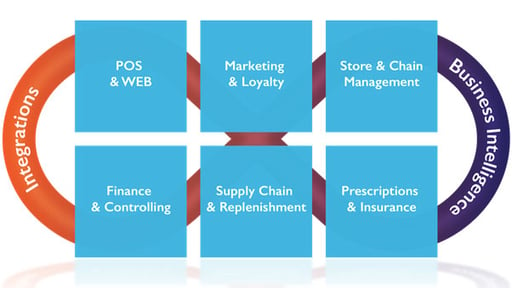How to digitalize your pharmacy processes

Many pharmacies are still operating on outdated, rigid legacy systems that were developed 10-20 years ago, and are slow to run, hard to update, and have obsolete capabilities. Today, pharmacies need technology that helps them deliver great customer service, while at the same time satisfying complex legislations and regulations. But they are unable to move to more competitive technology, because they are stuck in a vicious circle of reduced IT capabilities and growing costs, as the outdated technology requires continuous investment to stay up and running. As the pharmacy’s accounts are drained by the constant expenditure, it gets harder and harder to write off the existing software investment and invest into new, modern and flexible solutions that are easily upgradable and meet the current and future needs of the digital pharmacy.
Breaking the circle
If they want to still be around tomorrow, pharmacies need to make that call, and start investing in new technology – sooner, rather than later. It’s a big step to take, but a necessary one. The good news is that this kind of process can be done in phases, over time. The first step is to define a digital transformation program for the pharmacy.
Digital transformation
For management in pharmacies, some of the most challenging phases include defining future scenarios and planning a strategy for business development . During these stages, management needs to visualize possible scenarios, identify the preferred one, and then decide how the company intends to make that ideal future become reality. This can be a complex task. In order to define the vision, it is important to set up a digital transformation program, which involves implementing latest-generation digital solutions to handle processes, with the goal of becoming a modern pharmacy.
Defining goals and benefits
Business processes in the pharmacy industry are comprehensive, critical, and highly regulated. Many pharmacies that sell retail items also try to keep up with fast-moving trends in consumer behavior, so they can satisfy new generations of shoppers who demand convenience and 24/7 shopping and services online. When moving away from obsolete systems, it is important to clarify all the essential benefits and goals of the investment before making a decision on the new system. The digital architecture will need to support all critical processes efficiently and in a modular way: this way, you’ll be able to implement and maintain your software solution easily.
When researching new software solutions, there are three fundamental requirements you should look for:
- Functionality that supports and automatesdaily/regular pharmacy processes.
- Well-managed and scalable integration technologyto seamlessly connect to national databases, data sensors, external sources etc.
- The ability to use the data collected in the pharmacy operations to improve services and maximize revenue opportunities. For example, the transactions at the Point of Sale (POS) can provide you with valuable insights into consumer behavior, loyalty management, upselling opportunities, category management etc. A pharmacy running its data through business intelligence functionality can use this data to automate processes, and to create insights which will make them highly competitive.

The first steps
The question then is: how to establish a digital transformation program? An effective way to initiate this kind of program is to establish a reference group of internal subject matter experts. These experts can provide valuable input when it comes to creating the use cases for the future solution. This team should consist of the most knowledgeable employees with high motivation for change.
The following step consists in defining the benefits and goals for the digitization of the pharmacy processes. This part of the work is very important: this is where you identify how the new solution can support the strategic goals of the company. The goals should be quantifiable, and it should be possible to accomplish them by implementing a new management system. Some examples of goals that a pharmacy chain may set are:
- Grow the number of stores from 300 to 500 within four years.
- Grow the number of loyalty members from one to two million within three years.
- Shorten transaction time for handling prescriptions from six to four minutes.
- Integrate all the channels (eCommerce, physical stores, and mobile app) that our consumers use to shop within six months.
- Implement prescription handling on the mobile app within three months.
If the digital goals are defined in a concrete and tangible manner, it should be quite straightforward to set up an ROI calculation for the investment needed. The benefits of the digital transformation program can then be linked to the corporate vision and KPIs to visualize how the benefits are to be realized, and thereby document the business case for investing in a digital pharmacy program.
If you need help understanding what technology you need to achieve your goals, or how the right IT can get you to where you want your business to be, contact us. Our pharmacy technology team has helped several pharmacy chains worldwide reach their digital transformation goals.

